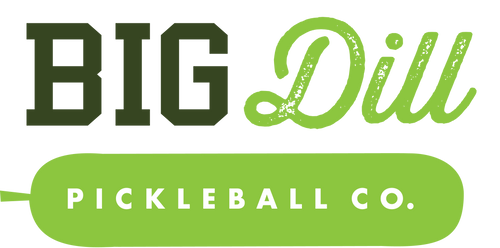Pickleball Glossary: Pickleball Terms, Pickleball Slang and all the Basic FAQs

If you’re interested in pickleball, you’re not alone! Pickleball is America’s fastest growing sport, and we know it’s definitely a big dill. Starting a new sport or hobby can be intimidating, so we’ve created a pickleball glossary and pickleball FAQ that’s great for new players, beginners, and beyond. Perhaps you’re looking to learn a bit more about your new favorite sport. Or perhaps you heard some pickleball slang or some pickleball terms you need to research. Use our pickleball guide to learn pickleball rules, pickleball court dimensions, pickleball scoring, and how to play pickleball. We’ve briefly summarized the most important points so you can browse before you hit the court. Happy pickling, picklers!
What is pickleball?
Pickleball is the world’s most-fun racket sport. It is played on a court that is 20’ x 44’ and is ideal for all levels of athleticism. Pickleball combines elements of tennis, badminton, and ping-pong. It’s played with a wiffle ball (a round, perforated plastic ball). It can be played doubles or singles, and like tennis, it can be played by men, women, mixed couples, adaptive players, and people of all ages. Opponents hit a pickleball over a 36-inch high net using composite or wooden paddles. After getting a serve into the opposite corner, players rally the ball back and forth hitting it out of the air or off a single bounce. A point can be scored by the serving team when the opposing team misses, hits out of bounds, hits the net, or commits another infraction. Serve passes to the next player and each point is played out.
Want to learn more? We’ve got your funny pickleball terms and a full court-load of pickleball terminology:
Ace
A serve that is not touched by the intended receiver, resulting in a point for the serving side.
Around the Post (ATP)
When a player hits a legal shot around the outside of the post on either side of the court. The shot will not go over the net, but around it.
Attack
When a shot is at an advantageous angle or height that allows a player to strategically execute a targeted offensive play.
Backhand
Using the side of a player’s paddle that positions the back side of their hand toward the net.
Backcourt
The area of the court just in front of the baseline.
Banger
A (sometimes annoying) player that only hits hard drives and shots at opponents.
Baseline
The back line marking the edge of the court.
Bert
The partner shot to an Erne. A shot where a player jumps to hit the ball, but rather than jumping on their own side, the player jumps to the partner's side or cross-court.
Body Shot
When the pickleball hits another player’s body. This is legal and results in a point.
Carry
A type of shot or hit when the ball is cradled and moved with the paddle direction rather than hit directly.
Center Line
The middle line dividing the court in half on either side from the kitchen line to the baseline.
Continental Grip
Gripping a paddle handle to create a V with the index and thumb on the paddle handle.
Cookie
An easy shot you should happily enjoy.
Dink
A soft, arching shot that bounces in the non-volley zone.
Doubles
Two players per side, four players total.
Double Bounce Rule
A basic pickleball rule that requires both teams to allow the ball to bounce. The serve must bounce, and the return shot must bounce. After this sequence, the ball can be volleyed.
Double Hit
When the ball strikes the paddle twice in one play. This is legal as long as it happens as part of one continuous stroke.
Double Elimination
In a tournament situation, this type of play would mean a team or player would need to lose twice (or two games) before being eliminated.
Drive
Powerful shot to the opponent’s backcourt.
Drop Shot
A soft shot that lands near the opponents non-volley zone. See also, third-shot drop.
Erne
Leaping shot made by a player legally traveling over the kitchen, as they hit the ball mid-air before landing out of bounds.
Falafel
A shot that doesn’t reach its full potential due to lack of power.
Flapjack
A shot that must bounce before being hit.
Foot Fault
A fault that occurs because of foot placement. This can be on the server (where the server steps across the baseline) or when stepping into the non-volley zone.
Graphite
A popular paddle-face material that is another way of describing carbon fiber.
Indoor Ball
A ball that has 26 holes.
Kitchen
Also called the non-volley zone. This marked court area is a 7-foot by 20-foot section adjacent to the net. Players may legally enter this zone at any time, but cannot hit a ball out of the air in this zone.
Kitchen Line
Or non-volley line. This line marks the beginning of the kitchen and stretches all the way across the court.
Lob
A high, arching shot hit to the opponents backcourt. Can also be called a “lobster” or “lobster pot” or many other annoying slang names that befit how obnoxious this shot can be.
Lines
Court boundary lines. Players must make an honest effort to determine if the ball was in or out. Lines on the court are all considered “in” with the exception of the kitchen line.
Nasty Nelson
When a server intentionally hits the non-receiving player with the ball, resulting in a fault for the receiving team.
Net Height
The pickleball net height should be 36 inches (0.91 m) on the ends where it connects to the posts. When properly set, the net will measure 34 inches (0.86 m) at the center. There should be 22 feet (6.7 m) from the inside of one post to the inside of the joining post.
Non-Volley Zone (NVZ)
Also called the kitchen. This marked court area is a 7-foot by 20-foot section adjacent to the net. Players may legally enter this zone at any time, but cannot hit a ball out of the air in this zone.
No Man’s Land
A tricky area in the transition zone. This is usually used to describe a situation where players get caught between running up and hitting a longer shot and often results in an error.
Out / Out of Bounds
Players may call a ball “Out” when it is headed out of the court boundaries. This may either warn a partner not to hit it out of the air, or tell the opponents it has been determined out of bounds. Players may also hold up one finger to signal the ball is out.
Outdoor Ball
A ball that has 40 holes.
Pickled
When a team gets no points. Get out the salt and vinegar, you just lost 0-11.
Pickler
A pickleball player, or one who is especially obsessed with pickleball.
Poach or Poaching
In doubles, when a player hits the ball in an area that was generally considered their partner’s responsibility or zone. This can be used strategically as a put-away shot or to confuse opponents. Or it can be really annoying.
Put Away
A shot to end the rally.
Rack
At public courts where rotational play is the norm, players will set up paddles in rows of four to determine turn-taking and court use.
Rally
Continuous play from the serve to the time of a fault resulting in a dead ball.
Ranking
Your ranking determines your skill level and provides an easy way to play with others at your same level. 2.0 will be a pure beginner and 5.0 will be a professional.
Regulation Paddle Size
USA Pickleball approved paddles must be used for sanctioned games and tournaments. USA Pickleball paddle size standards require the combined length and width of a pickleball paddle must not exceed 24 inches (0.61 m); the length cannot exceed 17 inches (0.43 m). This is why you will see some paddles that are shorter and wider, and some that are longer and narrower. Learn more about paddle regulations and approvals.
Regulation Pickleball Court
Pickleball court sizes are always 20 feet by 44 feet for all types of play (doubles and singles).
Return
A way to describe a shot hit back to the opposing side.
Reset
A way to keep the ball in motion or play without losing control, but also prevent an opponent from attacking or applying further offensive hits to your side.
Sandbagging
A nefarious tactic where players register for tournaments or games beneath their skill ranking in order to win.
Scoring
Like volleyball, pickleball uses sideout scoring where only the serving team can score a point. The score is called by saying the serving side’s score, the opponent’s score, and the server number. For example, “Seven - Two - Two” means the serving team has seven points, the opposing team has two points, and the server is the second server.
Scorpion
A shot hit from a squatting position where one hand pops up to hit the ball, much like the stinger of this insect.
Serve
The serve must start from behind the baseline with the server aiming diagonally. Play starts from the northwest corner of the court. Drop serves (where the ball bounces once before hitting) and volley serves (where the ball is dropped directly onto the paddle) are permitted.
Singles
One player per side, two players total.
Skinny Singles
A type of play with two players (one per side) played on half the pickleball court (often diagonally). This is a great drill for training your shots.
Smash
Or overhead smash. The player hits a high ball in a downward motion with speed and power so it cannot easily be returned. In inexperienced players, these balls often go directly into the net.
Stacking
A strategy in doubles that some teams use to attempt the most advantageous court position. This may change based on players’ specific abilities, point totals, speed, etc. Players should use caution when doing this as it adds to confusion and may contribute to a fault.
Switching
In doubles, a strategic swap of position to give advantageous position. May be communicated by hand signals.
Third-Shot Drop
The shot taken after a return of the serve that is strategically placed in the opponent’s kitchen. This gives your team time to move up and is mainly unattackable for the receiving team.
Transition Zone
The area between the kitchen line and the baseline, but more specifically, the middle of this area that is notoriously hard to defend.
Tweener
A shot hit between your legs.
USA Pickleball
The governing body of pickleball in the United States. USA Pickleball maintains a list of approved paddles, a list of approved balls, and an equipment standards manual.
Volley
Hitting the ball out of the air before it bounces.
Zero - Zero - Two
Or "zero - zero - start." The starting score in doubles pickleball.
What did we miss?
Feel free to let us know if there are any pickleball terms you're hunting for. Pickleball is always evolving, and we hope to help you have your best game ever!






Leave a comment